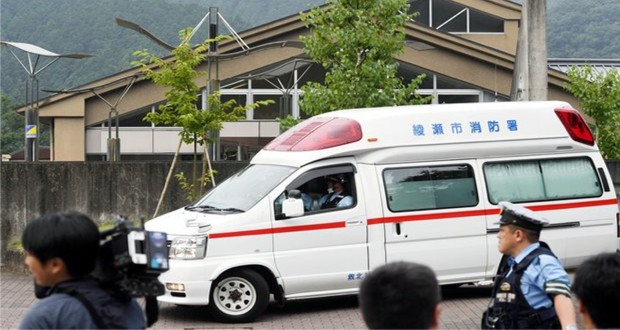Man armed with knives attacks facility in Sagamihara, outside Tokyo, before telling police: ‘It is better that disabled people disappear’
A man who claimed he wanted to kill disabled people left at least 19 dead and 26 others injured after a knife attack at a care facility in Japan.
Petrified staff at the Tsukui Yamayuri En (Tsukui Lily Garden) facility in Sagamihara, south of Tokyo, called police at about 2.30am local time after the suspect, named as Satoshi Uematsu, launched his attack. It was the country’s worst mass killing in decades.
According to the Kyodo News agency, emergency workers said at least 20 of the wounded had sustained serious injuries.
Meanwhile, Police in Kanagawa prefecture said Uematsu had driven to the nearby Tsukui police station and turned himself in after the attack.
“I did it,” the 26-year-old former employee of the facility was quoted as saying. “It is better that disabled people disappear,” he was said to have added.
Uematsu, a resident of Sagamighara, was carrying a bag full of knives and other sharp-edged tools, some of which were bloodstained, when he handed himself in.
A police spokesman declined to give details of the investigation, saying: “We are still confirming details of the case.”
Nine women and 10 men were killed, the fire department was quoted as saying, and they ranged in age from 18 to 70.
Police have yet to formally establish a motive for the attack. However, Uematsu was put in hospital earlier this year for almost two weeks after he said he would kill disabled people.
Authorities said Uematsu had been “involuntarily committed” to hospital on 19 February, after police in the town of Tsukui contacted him in response to a letter he had attempted to pass to the speaker of the lower house of Japan’s parliament.
In the letter, Uematsu argued that the government should permit euthanasia for disabled people, said he would be willing to carry out such killings himself, and detailed how he would do it.
“I envision a world where a person with multiple disabilities can be euthanised, with an agreement from the guardians, when it is difficult for the person to carry out household and social activities,” the letter said.
Uematsu’s letter said he could “wipe out a total of 470 disabled individuals” by targeting two facilities for disabled people during the night shift, “when staffing is low”.
“The act will be carried out speedily, and definitely without harming the staff. After wiping out the 260 people in two facilities, I will turn myself in.”
He was released from hospital on 2 March.
NTV said Uematsu had forced his way into the building by smashing a window with a hammer. The private broadcaster also said he had been upset after being fired, but that could not be independently confirmed.
The wounded were taken to at least six hospitals in the western Tokyo area. Twenty-nine emergency squads responded to the attack, Kyodo reported.
A man identified as the father of a person in the facility told NHK he learned about the attack on the radio and had received no information from the centre.
“I’m very worried but they won’t let me in,” he said, standing just outside a cordon of yellow crime-scene tape. Other relatives said they were still waiting to be given information about the rampage, news of which dominated early morning TV shows.
Images appeared of emergency workers removing the dead and treating the injured beneath a large orange tarpaulin screen.
A resident of the area, located in a mountain valley south of Mount Takao, told public broadcaster NHK that police had arrested a man with blond hair dressed in black clothes.
A woman who lives nearby told NHK that she saw police cars enter the facility at about 3.30am. “I was told by a policeman to stay inside my house, as it could be dangerous,” she said. “Then ambulances began arriving, and people covered in blood were taken away.”
The Tsukui Yamayuri-En facility is situated in three hectares (7.6 acres) of grounds. Established by the local government and located on the banks of the Sagami river, it cares for people with a wide range of disabilities. The facility has a swimming pool, gym and medical clinic, according to Kyodo.
The facility, 50 kilometres (30 miles) west of Tokyo, is home to 149 residents aged between 19 and 75; about 40 are over 60.
Mass killing are relatively rare in Japan, considered one of the safest countries in the world, but it has experienced sporadic, and deadly, attacks.
In 2001, eight children died and 19 other were injured when a man forced his way into a primary school and began a frenzied knife attack.
In 2008, seven people were killed by a man who slammed a truck into a crowd of people in central Tokyo’s Akihabara electronics district and then stabbed passers-by.
Fourteen people were injured in 2010 by an unemployed man who stabbed and assaulted bus passengers outside a railway station north-east of Tokyo.
Before Tuesday morning’s mass killing, the deadliest postwar attack committed on Japanese soil occurred in 1995, when members of the Aum Supreme Truth cult released deadly sarin gas on the Tokyo subway, apparently in an attempt to kill civil servants working at government ministries. That attack killed 12.
Credit: theguardian


